1 Why Teach?
“One of the lessons that I grew up with was to always stay true to yourself and never let what somebody else says distracts you from your goals. And so when I hear about negative and false attacks, I really don’t invest any energy in them, because I know who I am.”
Michelle Obama (personal communication, May 31, 2017)
Learning Objectives
- Determine your beliefs, motivation and goals for becoming a teacher
- Learn about experiences from Elementary, Middle and High school teachers as well as the perspectives of Bilingual and Special Education teachers
- Reflect on the qualities of an effective teacher
- Summarize the focal points for teacher content and pedagogical knowledge: philosophy, content, and communication
- Understand the role of reflection in teaching practice
In this chapter, we will begin to peer behind the scenes of what it means to be a teacher in the United States. We’ll walk through a day in the life of a teacher, break down what is involved to become a teacher, and close with characteristics of effective teachers.
1.1 A Day in the Life
To get started, let’s drop into four different classrooms to get a feel for a day in the life of an elementary teacher, a secondary (high school) teacher, a special education teacher and an immersion/bilingual teacher. In the following situations, imagine what it might be like to be a teacher in each setting.
Elementary Perspective
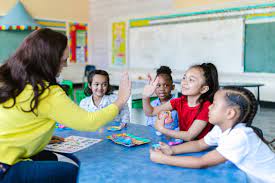
The school doors open at 7 AM, and you greet children as they enter the cafeteria for breakfast. Once morning duty is over, you hurry to your classroom to await the 25 students that will come filing in momentarily. You make sure materials and directions for tasks are ready and calming music is playing. As students enter, you gather signed forms and respond to notes from families, help students with their morning activities, take attendance, and hold a morning meeting. The rest of the day, you are simultaneously teaching the content areas–English, math, science and social studies–and social skills as students navigate group work and friendships. Various other educators drop in throughout the day: the reading specialist to work with a group of readers who need extra support, the occupational therapist to help a student with some motor skills still developing, the speech pathologist to help students with articulation and language development, the instructional coach and sometimes the principal to give you feedback on your instruction.
A day in the life of an elementary educator could involve students collaborating to create products of learning.
Pauses throughout the day from the busy pace of classroom life include related arts, where students go to learn about music, visual art, library, P.E., and more while you meet with your grade level for team planning; and lunch and recess, which involve scarfing down your lunch while getting your students through the lunch line, figuring out who changed their lunch choice or left their lunch at home, opening mustard packets, reminding students to eat while they talk with friends, and hopefully scuttling off to check your school mailbox and take a bathroom break. After a post-recess water break, you return to classroom instruction, with a few interruptions for students leaving early for doctor’s appointments, a student needing to go to the nurse’s office, another teacher popping in to borrow a book, or sometimes even a whole-school assembly for a class play or anti-bullying program.
When it is time to pack up for the day at 2:30, you make sure all students know how they are getting home that day, have their materials packed and ready to go, and then you bid them farewell at the door with a hug, high-five, or handshake as they head to their dismissal area. Once your room is empty, you go to monitor a dismissal area to make sure everyone is safe. After school, you might have a faculty meeting, a debrief with an instructional coach based on today’s observation, or time to prepare tomorrow’s instructional materials. You marvel at how quickly yet another day has passed in the life of an elementary school teacher.
Bilingual – Immersion Perspective
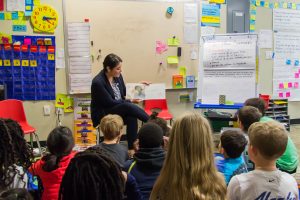
You are a Kindergarten Spanish immersion teacher. The model you follow in your school is called 90/10 which means you teach 90% of the day in Spanish and 10% of the day in English. This model includes students who are native Spanish speakers and students who speak other languages. As a kindergarten teacher you would like to develop units of study ahead of time and plan the steps students will follow to achieve their learning goal. This will allow you to be prepared and for students to have a predictable routine and learning structures. You will also like to start early in the morning so that you can work and focus on your lessons before staff and students arrive. The reason behind this is that after a day with kindergarteners, you will be exhausted and will not have the energy to plan and prepare for the following day. Therefore, think about this time for you to be on track and get ready for the day.
Students arrive and get their breakfast in the cafeteria where you pick them up. Since this is your first contact with students, you can greet them, and their families, and ask questions such as “how was your afternoon yesterday?” and maybe follow up on stories they have told you the day before. Students enjoy telling you stories, so this time is very valuable as you get to develop relationships with them. All of these conversations are held in Spanish as this is the target language.
Once students are done with their breakfast, they clean up their tables, they go to the restroom and line up to go to the classroom and start the learning. While students take turns going to the restroom, students play games, such as riddles; students are encouraged to bring their own riddles. This is a fun time for students as they get to laugh and guess, as some of the riddles, as you might know, are jokes as well. Students have the opportunity to tell their jokes and riddles in their mother tongue as some of them are not easy to translate. You can also take this time as an opportunity to develop language skills as well as critical thinking skills. In this class, students are the leaders/teachers. There is a teacher helper who leads the morning activity with the help of the teacher as well as the help of Susanita, the classroom puppet. You should see how much they love Susanita.
The rest of the day looks very similar to the one described in elementary. The only thing that varies, is that students are immersed in the target language, which in this case is Spanish. You, as the teacher, need to make sure students are not only learning reading, writing, science, math, etc., but are also learning the target language as they develop their English skills during their language time. Being an immersion teacher is very rewarding as you are encouraging and supporting students to be bilingual, biliterate and bicultural. This means that when students are bilingual, they can speak two languages; biliterate means that students can read and write in two languages; and bicultural means that students learn and appreciate their own culture and their classmate’s culture as well.
Secondary Perspective
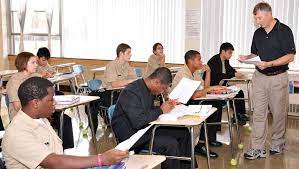
The bell rings at 8:15 AM, but you’ve already been at school for more than an hour–making copies, checking emails, and writing the plans and goals for the day on the board. As an English teacher, you’ve decided to work on writing fluency during this year, so as the students enter the classroom, they take out their journals and begin responding to the prompt on the board. Every day the class meets, the students will write for five minutes and then briefly discuss their responses with each other and as a whole group. You write alongside them to model what it looks like, and often share your own writing–at the beginning of the year, most of the students struggled to write for five straight minutes, but now nearly all of them have gotten the hang of it. The rest of the lesson involves a mini lesson on figurative language, small group discussions about students’ literature circle books, and a whole group review game to prepare for the unit test on Wednesday.
The school adopted a block schedule last year, so your classes are 75 minutes long. You teach three of four blocks each day; today is an A day, which means the first block is 9th grade honors and the other two are 10th grade general English. Tomorrow, you will teach two blocks of 9th grade general and one block of 10th grade College Preparatory English. You hate these labels and what they do to the students in the room, and, as department chair, you have been working with your principal to remove such rigid tracking.
A day in the life of a high school teacher could involve guiding students in their work, as this English teacher is doing.
“Bear Block” falls between 1st and 2nd block, and ten students stream into the room to retake tests, make up missed homework, or just hang out and read. You glance at the learning management system and see that there are 45 essays waiting for you, but there won’t be time to look more closely at them until later tonight. During lunch, some of your journalism club students are in the room, partially working on stories and layouts, but mostly sharing the latest news about their friends and acquaintances.
For the Professional Learning Community (PLC) meeting during fourth block, you will meet with the other 10th grade English teachers to look at the results of a common assessment. At some schools in the district, the grade-level teachers all teach the same lessons, but luckily at this school you have more freedom in how you teach the material. There is a new teacher on the team who is struggling with classroom management, so the first 15 minutes of the meeting is spent discussing some strategies that have worked in other teachers’ rooms.
The end of the day comes at 3:15 PM, but it will be another hour or two before you head home–there are sub plans to finish for Thursday because you will be attending a district-wide training for working with English Language Learners, and you are hoping to send at least ten texts and emails to parents. The initial fear of parent contact faded quickly, and now it’s one of your strengths–you reach out early and often, connecting with families around student successes first. Later, if students begin struggling, contact is much more seamless. It’s been a long, exhausting day, but interacting with the students has made it all worth it.
Special Education Perspective
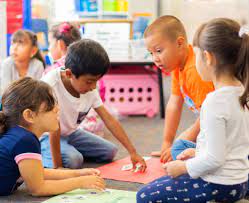
You arrive early in the morning, an hour or so before teachers officially start the school day. You greet the office manager, principal, and custodian on the way to your classroom. Aside from these three, the building will be mostly empty for another half hour. You’ve found that this quiet morning time provides the best opportunity to catch up on Individualized Education Plan (IEP) paperwork, reflect on student data from the prior day, and make adjustments to instruction for the coming day. As the official start time for the school day draws close, you make a quick dash to the copy machine, fingers crossed that it isn’t broken and that there isn’t a line of teachers anxiously waiting their turn. It’s your lucky day. Your last photocopies shoot out of the machine just as the overhead announcement calls teachers to report to their morning duty stations. You quickly drop the copies off in your classroom, pick up your data binder, and dash out the door to the bus loop.
The bus loop is a flurry of activity. You greet students with high-fives, occasional hugs, and countless reminders to “use walking feet.” Amid all of these informal greetings, you are slipping in some IEP services by completing morning check-ins with several students who have behavioral or social-emotional goals on their IEPs. From an outsider’s view, these check-ins don’t look that different from your interactions with any other student. However, intermixed with those high-fives and hugs you quietly assess needs, remind students of the goals they are working on, offer support where needed, and quickly make notes in your data binder. On this particular day, a third grader with autism reports that he is feeling like “a category 3 hurricane.” You know he needs some quiet time before joining his homeroom class, so you walk him to the computer lab where he has an open invitation to help the instructional technology specialist get the computer lab set up for the day.
The halls begin to clear as the instructional day begins. You spend the next six hours in constant motion, serving 18 students across four grade levels. You transition between co-teaching in general education classes and pulling small groups of students to your own classroom for intensive intervention in literacy, math, or social skills. When co-teaching, your job is to supplement the general education teacher’s deep knowledge of grade-level content with specialized instructional strategies that make content meaningful and accessible for students with disabilities and other learning differences. When providing intensive intervention, you implement research-based programs that target specific skills identified in your students’ IEPs. Data collection is on-going and individualized for each student, so your trusty data binder is by your side in all settings.
Normally, you would end the school day completing check-outs with the same students you saw in the morning. Today, you assign that responsibility to a teaching assistant so you can participate in a special education eligibility meeting. It is the initial eligibility meeting for this student and her family. A team of educators work with the parents to determine if the first grader has a disability and needs special education. Her parents feel overwhelmed by the process and fearful when the team concludes that their daughter has an intellectual disability. This is a moment when your job and your passion meet. You assure the parents that the future is bright for their daughter, that the educational label does not change who she is or who she will be, and that you will highlight her strengths and address her needs as you plan her education with them as equal partners. The decisions that you will make with this family are new to them, but for you they are a familiar and important part of your day as an elementary special education teacher.
The scenarios above describe some typical teaching days, but not all days are the same in teaching. In fact, each one will be different in some way. Deciding to become a teacher is an exciting commitment to shaping the future, and it is both demanding and rewarding. We will take a closer look at the teacher’s purposes and beliefs as we ask and reflect on what are the things that great teachers do differently.
1.2 Becoming a Teacher – Profile of Teachers Today
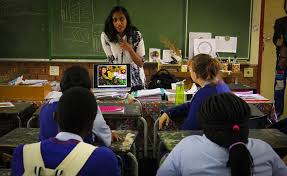
The National Center for Educational Statistics (NCES) collects data on various aspects of education, one of which is the demographics of teachers and students. In the 2020–21 school year, there were 3.8 million full- and part-time public school teachers, including 1.9 million elementary teachers and 1.9 million secondary teachers. In 2020–21, of all public school teachers, ninety percent held a regular or standard state teaching certificate or advanced professional certificates while fifty-one percent hold masters degrees. In 2020–21, the average base salary (in current 2020–21 dollars) for full-time public school teachers was $61,600.10 While salaries differ across the country, salary levels for teachers within states or school districts are often set based on teachers’ years of experience and education credentials (commonly referred to as “steps and lanes”).
Seventy-seven percent of public school teachers were female and 23 percent were male in 2020–21. In 2020–21, the proportion of K–12 public school teachers who were White (80 percent) was significantly higher than the proportion of K–12 public school students who were White (46 percent), whereas the proportion of teachers of other racial/ethnic groups was lower than the proportion of students in those groups. For instance, 9 percent of public school teachers were Hispanic, compared with 28 percent of public school students.
In 2020–21, of all public school teachers,
- 80 percent were White;
- 9 percent were Hispanic;
- 6 percent were Black;
- 2 percent were Asian;
- 2 percent were of Two or more races;
- Less than 1 percent were American Indian/Alaska Native; and
- Less than one-half of 1 percent were Pacific Islander.
Stop and Investigate – Demographics
The trends are clear: in the United States, we lack a racially and culturally diverse teaching force, and that trend has not changed much in the past 20 years. While the 2020-2021 school year included more Hispanic, Asian, and multi-racial teachers, teachers are still overwhelmingly White. In the same school year, however, students who attended public schools were only 45% White (NCES, 2020b). That means that generally, there are more White teachers and more students of color (Geiger, 2018). This trend is concerning, given that research shows that having teachers of color benefits all students, not just students of color (Wells, Fox, & Cordova-Cobo, 2016).
Video 1.1
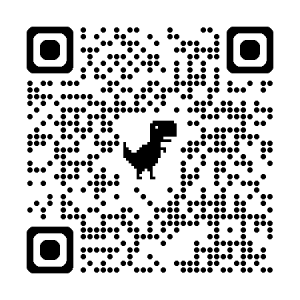 QR Code for Video 1.1
QR Code for Video 1.1
Increasing Diversity of Teachers Today
There are many reasons why teachers in the United States are not racially diverse. While the U.S. Supreme Court’s 1954 decision in Brown v. Board of Education demanded all schools integrate to address some of the inequalities between separate schools for White and Black students, it did have other consequences that directly impacted the diversity of teachers in the United States. Recent reviews of archival data estimate that from 1964-1972, in 781 school districts across the south, 31.8% of Black teachers left the teaching profession (Thompson, 2019). Some were pushed out of the profession while others migrated north to continue teaching. Some Black teachers entered occupations which required lower skill levels. (Milner & Howard, 2004; Thompson, 2019). To make up for the loss, districts hired white teachers from both genders, who were new to the field or who lacked training.
Even though this historical antecedent did limit access to teaching jobs for Black people, racial discrimination in the hiring process continues to compound this issue. D’Amico et al. (2017) found that despite equally-qualified candidates applying for jobs in one large school district, White teacher candidates still received a disproportionate number of job offers: of the 70% White applicants, 77% received job offers, while of the 13% Black candidates, 6% received job offers (D’Amico, Pawlewicz, Earley, & McGeehan, 2017; Klein, 2017). Beyond the hiring process, retention of hired teachers is lower for teachers of color than for White teachers. For example, between the 2011-2012 and 2012-2013 school years, only 15% of White teachers left their jobs, compared to 22% of Black teachers and 21% of Hispanic teachers (U.S. Department of Education, 2016). Teacher disparities also exist within zip codes. Evidence indicates that teachers are tied to the communities they serve.
Research indicates that roughly 60 percent of educators choose to teach in a region close to their home, or to their university (Reininger, 2011). Beginning teachers may opt to teach near places which are familiar to them and they may already feel a sense of belonging in their home communities.
Recently, there have been efforts to capitalize on the connections teachers have with certain home communities. Those who reside within a community have relationships and networks centered within the region. Rather than recruit outsiders, or those who are from different areas, recent efforts have focused on targeting individuals who live in the community. Recruiters believe these individuals may be more invested in the students and may be intrinsically motivated to help them succeed. Some regions have developed “Grow-Your-Own” initiatives and have developed scholarships to specifically target members of a community. The term, “Grow-Your-Own,” implies that a neighborhood can grow its own educators, rather than recruit teachers from far away places.
The term, “Grow-Your-Own” is relatively new, however, the idea of recruiting teachers from specific regions has been in existence for quite some time. School districts are now expanding this idea and are starting to reach out to students of color in the hopes that teachers can start to bridge the divide between educators and classroom populations.
Deeper Dive – Grow Your Own Initiative
Check out this inspiring article about the “Grow your Own” Initiative – Oregon districts turn high school students into future teachers through ‘Grow Your Own’ efforts
In order to combat the staffing shortages which are widespread due to the Covid-19 Pandemic, school districts have developed their own ways to harness the talent of those individuals who work within the community, or who work at the school. Bus drivers, education assistants, school volunteers and parents have begun to think about working as long-term substitute teachers. Some of these individuals attend community colleges to begin to obtain their teaching credential and learn about the pedagogical strategies of education pathways.
Critical Lens – Capitalizing Race Terms
You may have noticed in this section that races are capitalized (like White and Black). Capitalizing these names recognizes the people more than the color. In fact, the Associated Press recently changed its writing style guide[2] to capitalize Black and Indigenous when referring to racial categories.
1.3 What do Great Teachers Do Differently?
Reflect on your experience as a student in a K-12 classroom. Your experiences as a student may have been varied. If you cannot call to mind an experience easily, think about a learning experience from a coach, mentor or relative. Think of a task or situation where you learned a new skill or mastered a content area. When you think about your relationship with this individual, what three words come to mind?
Video 1.2
Activity – Icebreaker
Can you name three Characteristics of an effective teacher?
- Think about a teacher who made a difference in your life and why?
- What specifically did they do or say that made a difference for you?
- How does this inform the kind of teacher you hope to be?
- This could have been a positive or negative teacher experience.
As a student, you may have attended school in a rural community, in a setting where there were small class sizes, in a school with a variety of students from various ethnic and cultural backgrounds. Or, you might have been in a school with a large population in an urban community. Consequently, as former students, you all bring these experiences and points of view with you into the classroom. Teachers who are effective in reaching students of diverse backgrounds recognize these various types of knowledge as student assets.
Students bring knowledge with them as they enter schools and classrooms. In fact, their first teachers are their parents, extended family members, and members of the church and community leaders. In these spaces, they begin to learn the values of their family. They learn the habits and customs regarding when to bring to another member of the family, or what work entails. They receive an education in these settings. The students bring this knowledge base with them to school. (Moises Esteban-Guitart, 2021).
When considering how students learn, one crucial factor involves the teacher and student relationship. As we examine the characteristics of effective and ineffective teachers in our school experience, it is likely we will see correlations between the student-teacher relationship (STR) and our performance or lack of ease in the classroom. As we look at teaching through this lens, we come to understand that teaching content is only one aspect of the teacher role. Creating an emotionally caring and educationally supportive environment in our classroom can give us an advantage in engaging students for learning.
The following TED Talk Video is presented by Ms. Rita Pierson. Ms. Pierson is an inspiring former teacher who has a philosophy that all students can learn, and that a teacher can lift students to heights they never thought they could achieve. This presentation focuses on practical success and failure resulting from classroom relationships. Often pre-service teachers believe that they are preparing for a career that will require them only to teach the content. However, as teachers, we cannot shy away from the fact that we also teach complex human beings.
Video 1.3
1.4 Teacher Purposes and Beliefs
After watching the video from Rita Pearson, consider the importance of establishing caring and trusting relationships with your students, as well as the importance of believing in them by acknowledging any effort they are making.
Now, we are moving to another important aspect of teaching and that is to convey content to their students. Teachers need to express why the content they teach is important to learn. For elementary teachers, the necessity for students to learn how to calculate, read, and write is a given, but the answer is not as clear for other subjects: music, science, physical education, history, and art. Many parents do not see the need for their children to study a subject past a certain point. In order to ground why content is important, reflection and creation of a personal philosophy is essential.
Teachers enter the profession for a variety of reasons. Some educators are motivated by intrinsic factors, such as the need to “give back” to the student population and help to inform the next generation. Some educators believe their work contributes to creating a more just society. Those who are motivated by intrinsic factors, or factors which are internal and come from within, often find that they pursue their passions. On the other hand, some teachers are also motivated by extrinsic factors. Extrinsic factors could include a reward, monetary compensation, or another external factor. No matter what your motivation is for teaching, all future educators need to understand teacher knowledge and how to apply it on a daily basis.
1.5 Teacher Knowledge: Content, Pedagogical and Curricular Knowledge
“Knowledge is power. Information is liberating. Education is the premise of progress, in every society, in every family” -Kofi Annan.
If teaching is the highest form of understanding, as Aristotle claims, then what are the forms of understanding and how might we develop a framework for articulating this understanding? This complex understanding is part of the foundational requisites of teacher knowledge. According to Gudmundsdottir & Shulman (1987), there are three main foci that form the foundation of teacher knowledge: Content knowledge, pedagogical content knowledge, and curricular knowledge.
Content knowledge: Understand the standards that are required to be taught through a culturally responsive lens. This means that teachers must understand the population they are working with so that standards can be addressed in a multicultural environment.
Pedagogical Content Knowledge: Understand what are the difficulties that students might encounter as they learn about a new topic. This means that teachers need to assess the developmental appropriateness of the topic in relation to their students. In order to achieve this, teachers must develop close relationships with students to be able to learn about their background, motivations and learning styles in order to guide students’ achievement of their goals.
Curricular Knowledge: Knowledge of curricular materials to teach particular topics and ideas. Teachers should be able to identify and evaluate different perspectives and points of view in a subject matter so that they avoid teaching stereotypes or implicit biases that are printed in some textbooks.
In addition to these three foci, a teacher needs to develop a philosophy, or purpose, in which they have a research based approach to the learning conditions, goals for learning and strategies to use in the classroom, so that students learn the content. The development of and adherence to a research based philosophy of teaching and learning serves as a teacher’s guidelines for curricular choices, for the implementation of classroom community strategies, and for building relationships with students as well as colleagues. We will dig deeper into our philosophy of teaching as we advance in this text.
1.6 Lifelong Learning, Reflective Practitioner, and Mentoring
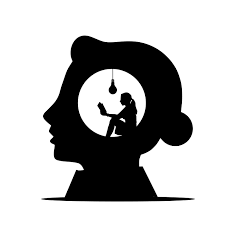
Teachers engage in the process of lifelong learning as a way to meet the needs of their students, respond to best practices in the literature and research, and try to integrate the newly acquired approaches to support student learning. Some examples of lifelong learning, also known as professional development, may be attendance at a conference, mentoring (either as the mentee or mentor), joining a professional organization, and conducting research. As an undergraduate student pursuing your Bachelors Degree in education, you are immersed in a constant environment of learning.
Let’s embark on the journey of becoming reflective practitioners as becoming a master teacher takes continuous effort. Since teaching is a repeated process in which you plan, reflect, and adjust based on a student’s learning, achievement and engagement, reflection is one habit that you must acquire to be able to improve your practice.
Dylan Wiliam describes this in the following video as the life-long process of a teacher.
Video 1.4
Dewey (1938) argued that reflective practice promotes a consideration for why things are as they are and how we might direct our actions and behavior through careful planning. When we underpin this planning with experience and theory, we become much more impactful. To make this point clear, we learn from reflecting on our experience and not solely from our experience. This means that it is the lessons we reflect on that move us forward.
Donald Schön (1987), a philosopher and educational researcher, took reflective practice a little further and defined two processes: reflection-in-action and reflection-on-action. This means that we need to observe, reflect and rapidly adjust our teaching in the moment, versus the process to reflect and look back to be able to adapt our lessons. To elaborate on Schön’s point, we can affirm that learning to teach often means making choices and taking actions without knowing in advance what we need to learn or what the consequences will be. Thinking about these notions encourages teachers to be reflective practitioners; a professional who learns both from experience and about experience.

On the other hand, the Frankfurt school of critical social theory (1929), talks about the importance of moving from growing as an individual to changing a whole society; in this case, your classroom. According to these theorists, a “critical” theory may be distinguished from a “traditional” theory according to a specific practical purpose: a theory is critical to the extent that it seeks human “emancipation from slavery”, acts as a “liberating … influence”, and works “to create a world which satisfies the needs and powers of” human beings (Horkheimer 1972b [1992, 246]). Because such theories aim to explain and transform all the circumstances that enslave human beings, many “critical theories” in the broader sense have been developed.
Video 1.5
With these perspectives, we can argue that both schools of thought are beneficial when talking about reflective practitioners. Teachers who think about their practice, reflect on the impact of their practice, and evaluate their practice in terms of student understanding. Here, we move from our own personal growth to the growth and change of our society.
Now, let’s talk about when we should start reflecting. A good starting point is for us to learn from our own teaching. We need to reflect, or think, about the implications that our own values and experiences bring to the classroom. With this being said, reflection on practice is something we must do for ourselves, since only we have had our particular teaching experiences and only we can choose how to interpret and make use of them. But this individual activity also may benefit from the perspective and feedback offered by fellow professionals. Others’ ideas and values may differ from our own, and they can, therefore, help in working out our own thoughts and in bringing new ideas that we may otherwise take for granted. Collectively reflecting on a subject area or lesson plan is an excellent way to help evolve ideas or strategies that can improve our own practice.
Reflection can happen in any number of ways, but here, we are going to list five general categories:
- Reflecting on your own practice
- Talking and collaborating with colleagues
- Participating in professional associations
- Attending professional development workshops and conferences
- Reading professional literature
John Kamal (2020), in his article Making Time for Reflective Practice shares some practical ideas and helpful tips to become an effective practitioner as you reflect on your own teaching practices. For example, taking notes after a lesson can support you as a teacher. You can reflect on the aspects of the lesson that went well and the aspects that need some adjusting. Reflecting on your practice is a powerful development tool for teachers. Teachers who consider these schools of thought, strategies, and expectations are on the path to becoming reflective practitioners, professionals who learn both from experience and about experience.
Critical Lens – Making Time for Reflective Practice
Read the article at https://www.edutopia.org/article/making-time-reflective-practice
Regarding mentoring, in the United States, there are some states who require mentoring programs for beginning teachers and administrators. For example, California, New York, Hawaii, Kansas, Pennsylvania, and other states have teacher induction requirements for first-year teachers. As a first-year teacher in these states, you will be assigned a mentor in your district who will serve to support and guide you through the challenges, questions, and joys that your first year of teaching will offer. Strong mentor-mentee programs increase the development of a new teacher’s connection to the school community and reduce isolations (NYSED, 2013).
Conclusion
Why do teachers teach? It is something inside them. It is a drive, a force, a passion, a desire to engage with their students in order to watch them succeed. Choosing to be a teacher is not a monetary pursuit, as a teacher’s salary is hardly adequate considering all that they give to their students. Becoming a teacher is often considered a calling. It is not for the light of heart, but rather, for those who love children and people, who have a passion for education, and who understand its impact on improving lives and creating a more just society . Most teachers love to learn and hope to encourage that fundamental human process of discovery and growth in others.
Licenses and Attributions
Foundations of Education: A Collective Reimagining is adapted from the following three texts:
- Foundations of Education by Tasneem Amatullah, Rosemarie Avanzato, Julia Baxter, Thor Gibbins, Lee Graham, Ann Fradkin-Hayslip, Ray Siegrist, Suzanne Swantak-Furman, Nicole Waid. Foundations of Education Copyright © by SUNY Oneonta is licensed under a Creative Commons Attribution 4.0 International License, except where otherwise noted.
- Foundations of American Education: A Critical Lens Copyright © by Melissa Wells and Courtney Clayton is licensed under a Creative Commons Attribution-NonCommercial-ShareAlike 4.0 International License, except where otherwise noted.
- Foundations of Education by Jacqueline M. DiSanto, Hostos Community College under a Creative Commons Attribution 4.0 International License, except where otherwise noted.
Modifications by Tanya Mead, Ceci DeValdenebro, Kanoe Bunney and Lisa AbuAssaly George, licensed under a Creative Commons Attribution-NonCommercial-ShareAlike 4.0 International License, except where otherwise noted, include a reorganization, videos, images, activities and significant rewriting.
References
American Psychological Association. (2010). Publication manual of the American psychological association Washington. DC: American Psychological Association.
Bohman, J. (2005, March 8). Critical Theory. Stanford Encyclopedia of Philosophy. https://plato.stanford.edu/entries/critical-theory/
Bridges, F. (n.d.). Michelle Obama’s Best Advice To Young People. Forbes. Retrieved August 30, 2023, from https://www.forbes.com/sites/francesbridges/2017/05/31/michelle-obamas-best-advice-to-young-people/?sh=d4edbb150832
Chard, S. (2014). No more bad coffee: professional development that honors teachers. Ted talk. Retrieved from: https://www.youtube.com/watch?v=aiW0s6_83dw
Dewey, J., 1938. Experience in Education. New York, NY: MacMillan
DiSanto, J. M., & College, H. C. (2014). Why Teach. Library.achievingthedream.org. https://library.achievingthedream.org/hostoseducation/chapter/foundations-of-education-and-instructional-assessmenteducator-as-a-professionalwhy-teach/
Dweck, C. S. (2008). Mindset: The new psychology of success. Random House Digital, Inc..
Gudmundsdottir, S., & Shulman, L. (1987). Pedagogical content knowledge in social studies. Scandinavian Journal of Educational Research, 31(2), 59-70.
Knoll, J. (2017). The do’s and don’ts of social media for teachers. Retrieved from the We Are Teachers website: https://www.weareteachers.com/dos-donts-social-media-for-teachers/
Lasswell, H. (1964). The structure and function of communication in society. In W. Schramm (Ed.), Mass communications. Urbana, IL: University of Illinois Press.
Mariconda, B. (2003). Easy and Effective ways to communicate with Parents. Scholastic Inc.
Moises Esteban-Guitart (2021) Advancing the funds of identity theory: a critical and unfinished dialogue, Mind, Culture, and Activity, 28:2, 169-179, DOI: 10.1080/10749039.2021.1913751
NYSEG. (2013). Office of teaching initiatives: Mentoring. Retrieved from: http://www.highered.nysed.gov/tcert/resteachers/ mentoring.html
Quin, D. (2017). Longitudinal and contextual associations between teacher–student relationships and student engagement: A systematic review. Review of Educational Research, 87(2), 345-387. Retrieved from: https://journals.sagepub.com/doi/abs/ 10.3102/0034654316669434?casa_token=IjQdlgCqZjsAAAAA:9UQQr- Y90eCIKGx3ryK6D3Ic1kETPirML5FHF2e4B3KhIEFdaTkC1G72vTZWv34PyXVvPu-CwPnPhg
Patrick, H., Anderman, L. H., Ryan, A. M., Edelin, K. C., & Midgley, C. (2001). Teachers’ communication of goal orientations in four fifth-grade classrooms. The Elementary School Journal, 102(1), 35-58.
Pierson, R. (2013). Every child needs a champion. Ted talks. Retrieved from: https://www.youtube.com/watch?v=SFnMTHhKdkw
Procee, H. (2006). REFLECTION IN EDUCATION: A KANTIAN EPISTEMOLOGY. Educational Theory, 56(3), 237–253. https://doi.org/10.1111/j.1741-5446.2006.00225.x
Purdue, O. W. L. (2019). APA Formatting and Style Guide. Retrieved from: https://owl.purdue.edu/owl/research_and_citation/ apa_style/apa_formatting_and_style_guide/
Reininger, M. (2012). Hometown Disadvantage? It Depends on Where You’re From. Educational Evaluation and Policy Analysis, 34(2), 127–145. https://doi.org/10.3102/0162373711420864
Shon, D. (1987). The Reflective Practitioner. London: Arena.
Silver, F. (2018). Why is it important for teachers to have good communication skills? Retrieved from: https://work.chron.com/ important-teachers-good-communication-skills-10512.html
Simpson, M. (2010). Cyber Speak no evil. Retrieved from the NEA website: http://www.nea.org/home/38324.htm
Wells, G. (2006). The language experience of children at home and at school. In J. Cook-Gumperz (Ed.), The social construction of literacy, 2nd edition, 76–109. New York: Cambridge University Press.
Wells, M., & Clayton, C. (n.d.). Chapter 1: The Teaching Profession. Viva.pressbooks.pub. https://viva.pressbooks.pub/foundationsofamericaneducation/chapter/chapter-1/
Images
1.1 “Where are All the Millennial Teachers of Color?”, New America
1.2 “A Teacher and a Girl Doing a High Five “ by RDNE Stock project- free stock photo is in the Public Domain, CC0
1.3 “Amistad School Visit” by , Wikipedia Commons is in the Public Domain, CC0
1.4 “Mooseheart High School science teacher Curt Schlinkman “ by PICRYL is licensed under CC BY 4.0
1.5 “Special Education Sees Historic Boost in funding” by Laura E. Hernández , Learning Policy Institute is licensed under CC BY 4.0
1.6: “Black Teacher Images” by U.S. Embassy South Africa , Raw Pixel is in the Public Domain, CC0
1.7 “Feminist Perspectives on Learning, Media and Technology – femedtech” by Raw Pixel is in the Public Domain, CC0
Videos
1.1 “Why Teachers of Color Matter for Students of Color to Succeed”, Edutopia is licensed under CC BY 4.0
1.2 “The Day I became a good teacher” by Heimlers History teachers is licensed under CC BY 4.0
1.3 “Rita Pierson: Every kid needs a champion” by Youtube is in the Public Domain, CC0
1.4 “Teacher Reflective Practice” by Dylan Wiliam, Youtube is in the Public Domain, CC0
1.5 “Critical Theory as a Philosophy of Research” by Youtube is in the Public Domain, CC0

